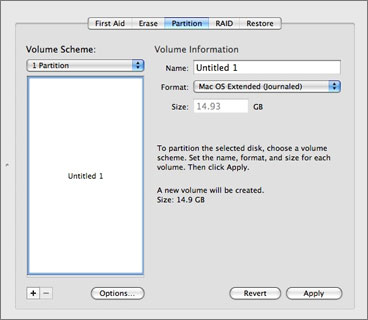

In this case, as there is only one volume on the drive, you can select either the physical hard drive name or the volume name. If you select either the physical hard drive or the volume and the tool you want to use is grayed out and not available, then simply select the other name in the left hand column. With some of the Disk Utility tools it does not matter which you select, the physical hard drive or the volume. Other tools are applied to Volumes, like First Aid or Erase. Some of the Disk Utility tools are applied to the Hard Drive itself, like Partition. The reason that Disk Utility shows drives and volumes in this way is because Disk Utility has a number of different tools, First Aid, Erase, Partition, RAID, Restore, Repair Permissions, Verify and Repair Disk, Mount, Eject, etc. For example, seeing a drive listed in the left hand column with 2 or more names, can be confusing. I have a 'Partitioning a Hard Drive' article for you, if you want to read up on partitioning, but the reason for this article is to address the common confusions and questions when people use Disk Utility for the first time. If the drive is to be used as a media drive for video editing, then for the best speed performance, avoid using partitions.
/GettyImages-471646522-5bf4b3c84cedfd0026351720.jpg)
A hard drive with three volumes will show on the desk top as three separate drives. If we have more than one volume on a hard drive, each volume will show on the desk top as a discrete or distinct drive. The first volume might be 'Current Projects', the second, 'Media' and the third, 'Archives'.

You could divide a one terabyte drive into three volumes or partitions. Partitioning a drive, creating additional volumes, is most often done for organizational purposes. Using Disk Utility, we can 'partition' or divide up the space on the hard drive into smaller, independent sections called 'volumes'. The second name is the name of the 'Volume'. This name includes the formatted size of the drive and the name or abbreviated name of the manufacture. The first or top name, is the name of the hardware, the physical hard drive itself. Looking at the list of items you'll notice that each drive is listed twice, with two different names. All installed (connected) Hard Drives, CD and DVD drives, Partitions, or any Disk Images' that you have on your Mac will be displayed in this column. These items are listed in the left column of Disk Utility, as shown below. When Disk Utility opens it will ask you to 'Select a disk, volume or image'. I use Disk Utility on a regular basis, so I have dragged the Disk Utility icon from the Utilities folder down to the Dock, for quick access. We want to the launch the Disk Utility application which is found in the Utilities folder inside the Applications folder on your Macintosh Hard Drive. In this case it is named 'Untitled', but could have any name. When I plug it into my Mac, the hard drive icon mounts on the desktop. Considering that you'll be using this drive for years and that you may be using it to store valuable information, I would suggest that you spend a few minutes to reformat and test the drive using the Mac Disk Utility to be sure that you get off to the best start.įor this article I am going to work with an old LaCie external Firewire drive that I have wiped clean. It could be formatted as 'FAT 32', a format that will run on both Macs and PCs, but does have limitations. You can plug this new drive into your Mac and 'go to work', but this does not mean that the drive is setup in the best manner for the Mac. When you purchased the drive, the sales person told you that it was Mac compatible, just plug it in and go to work. It could be an internal drive but most likely it is an external hard drive that has Firewire 400, Firewire 800, USB 2 or eSATA ports on the back for connectivity to your Mac.
:max_bytes(150000):strip_icc()/004A-format-mac-drive-using-disk-utility-os-x-el-capitan-later-2260751-0fe2db79938b490fa04cc4c670978e5a.jpg)
You have just purchased a brand new hard drive for your Mac.


 0 kommentar(er)
0 kommentar(er)
